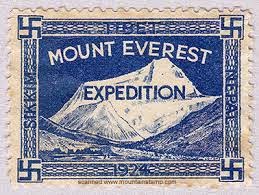Sea-blue Nordic cross on white field, rectangular Coat of Arms of Finland (colors gold and silver on red), swallow-tailed, Cross of Liberty in canton (colors gold on blue)
The Finnish presidential standard at the Presidential Palace, Helsinki.
The Flag of the President of Finland has in the canton what is best described as an heraldic ‘cross-pattee’, in blue, charged with a yellow “Fyflot” (Fylfot ?), or Swastika-shaped cross, the Cross of Freedom, Finland’s most distinguished Order (vide, Flags of the World by EMC Barraclough). In Finland the swastika appears as a part of "tursaansydän", an ancient symbol of luck and protection
Swastika in the Finnish Air Force
RC- 33 Thulin type D, Finland (skis) 1917
Von Rosen had painted his personal good luck charm on the Thulin Type D aircraft. This charm – a blue swastika, the ancient symbol of the sun and good luck – was adopted as the insignia of the Finnish Air Force
The swastika of the Finnish Air-force was adopted when Swedish Count Eric von Rosen donated the first aeroplane to the Finnish government, adorned with his personal good luck symbol blue swastika. (http://www.crwflags.com/fotw/flags/fi_xfree.html
Victory of the White Army over the Red Guards
(Fylfot at the top left
corner)
1938:
2m + 1/2m blue semi-postal
During WW2, people in Europe and North America stopped buying Carlsberg Beer(Biggest Danish brewery) because of the presence of Swastika
Carl Jacobsen adopted a swastika as the logo for "Ny Carlsberg" ("New Carlsberg") beer—a reference to the purity of its ingredients. After 1906 came the swastika within the star. By 1940, however, the rise of Nazi Germany and its perverted interpretation of "purity" had led Carlsberg to abandon the swastika permanently—and the subsequent German occupation pretty much assured that it would not be re-adopted. (Source: https://www.facebook.com/Asliceofworldhistory?fref=photo).
A slice of World History For anyone visiting Denmark... Carlsberg breweries in Copenhagen were built long before WW2 and you can still see large swastikas engraved into the shields of four large stone elephants holding the old brewery building... ~Arun Advaid
Luke Lesage In Dublin, Ireland, a laundrette by the name of Swastika Laundry existed (name and logo!) until the mid 1980's!
More Swastika Logos in India
 The
logo of Indira Gandhi National Centre for the Arts, adopted from the famous Badami
ceiling, is a solar symbol representing light and movement and the
interpenetration of autonomous units. It shows four Svastikas intertwined
together. The symbol represents the cyclic path of time and seasons which
reflects germination, growth and decay. http://ignca.nic.in/
The
logo of Indira Gandhi National Centre for the Arts, adopted from the famous Badami
ceiling, is a solar symbol representing light and movement and the
interpenetration of autonomous units. It shows four Svastikas intertwined
together. The symbol represents the cyclic path of time and seasons which
reflects germination, growth and decay. http://ignca.nic.in/
The Svastika is known to all
ancient cultures of the world and has been found in Hesserik, Greek,
Indonesian, Chinese, Japanese, Iranian, Buddhist, Jain, Pueblo Indian, Mexican
and Malaysian traditions. The symbol has pervaded the Indian arts from Harappan
seals to the contemporary arts.
 This swastika pattern from the famous Badami ceiling.
This swastika pattern from the famous Badami ceiling.
Badami formerly known as Vatapi, is a town in the Bagalkot
districtof Karnataka, India. It was the regal capital of the Badami Chalukyas
from 540 to 757 AD. It is famous for rock cut and other structural temples.
Indira Gandhi National Centre for the Arts, New Delhi is the premier
government funded arts organization in India, as an autonomous institution
under the Union Ministry of Culture. Established in the memory of Indira Gandhi,
late Prime Minister of India.
Logo of the University of Dhaka, Bangladesh, 1921-1952
Logo of Visva Bharati University,
Sanitiniketan, West Bengal. The logo was created by Nandalal Bose.
Visva-Bharati University was founded by Rabindranath
Tagore who called it Visva Bharati, which means the communion of the
world with India. In its initial years Tagore expressed his dissatisfaction
with the word 'university', since university translates to Vishva-Vidyalaya,
which is smaller in scope than Visva Bharati. Until independence it was
a college. Soon after independence, in 1951, the institution was given the
status of a university and was renamed Visva Bharati University. (http://en.wikipedia.org)
Santidev Ghose, the stamp was issued in December 2002,
also has the logo (part) of the Visva Bharati University.
Santidev Ghose ( May 7, 1910 – December 1, 1999) was
an Indian author,
singer, actor, dancer and maestro of Rabindra
Sangeet. Santidev joined Visva-Bharati University as a teacher in
1930. Later he became Professor and Head of the Department of Rabindra Music
and Dance at Sangit-Bhavana, the music department of Visva-Bharati University. He also served
as the Principal of the institute between 1964–68 and 1971-73.
Logo of Rabindra Bharatii University, Kolkata, West Bengal.
Rabindra Bharati University is a university
in Kolkata, India. It was founded
on May 8, 1962, to mark the birth centenary of the poet Rabindranath Tagore. It is located at the Tagore
family home, Jorasanko Thakur Bari. (http://en.wikipedia.org)
Current
logo of Kolkata Municipal Corporation, adopted on 22 February, 1961
At the bottom left there is a swastika symbolising all-round prosperity
1924 British Mount Everest Expedition led by Lieut. Col. Norton. Label showing Mt. Everest with base camp with marginal inscriptions TIBET - NEPAL - SIKKIM and with Swastika in the four corners symbilising good luck for the expedition. The stamps were used on mail from base camp to nearest Indian P.O.
Swastika in Commercial Art


.svg.png)

















